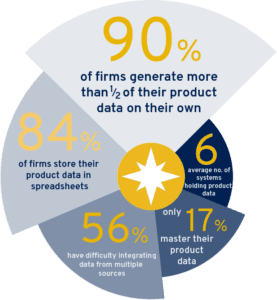What is a Product Master?
A product master solution is a data management solution that compiles, validates, enriches, and curates all your organization’s product-related data into a complete, accurate, and easily reportable golden copy. Some examples of product-related data include product types, product lines and groups, product pricing (billing) schemes, product hierarchies and historical product details.
Unlike securities or client data, which is generally uniform (or at least well understood) across the industry, product data varies from organization to organization. In fact, it’s often hard to find a shared definition of a product within the same organization. The product offerings themselves are different, as well as product lines and hierarchies, which makes defining the data to manage products difficult.
A good product master, however, will establish the right workflows and critical data elements (CDE’s) within product attributes. It will also identify processes by which to ingest and govern that product data, regardless of how that may be defined within the organization.
Why do I need a product master?
At the operational level, companies create large and ever-increasing amounts of product related data. This data is created by multiple varying, and sometimes siloed, groups within an organization, all with their own specific objectives for that data. For example, as one group creates new, complex, and customized products to sell to their clients, another may be interested from which division, branch, or sales (i.e. distribution) channel those products have been sold, while yet another may be interested in the nuances and laws of the local region being sold into. All of this data needs to be aggregated and cleaned so that every department, as well as the management team, has access to a single complete and accurate version of the data, allowing the organization to become more efficient in day-to-day tasks and decision making.

Source: Cutter Associates
This efficiency lends itself to a host of beneficial results for the organization. A link between the products, target and current customers and tradeable assets allows for a holistic view of the data, making it easier to measure and assess risk and performance. This in turn allows the company to be more nimble in making informed decisions about its products, without allocating more time or resources to the process than necessary. It also provides a competitive edge by decreasing time-to-market from idea to launch. All this to ensure that products end up in the hands of the right clients faster, cheaper, and easier, which makes the organization money.
Having complete and accurate data in a central place also alleviates the burden of complying with the inevitable and ever-expanding regulatory pressures faced by firms in today’s market. All regulations, such as Dodd-Frank, FRTB, and MiFID II, have similar core requirements for reporting and transparency that companies are expected to comply with under threat of heavy fines. Having quality data, as well as workflows that govern the data, proactively addresses these requirements at the foundational level. Compliance is done once and done right, while effectively future-proofing the data from any regulation that may show up down the road. Proactively achieving compliance, as opposed to reacting to regulations as they arise, saves firms time and money, while saving senior management sleepless nights.
What should I look for?
First you have to decide whether you’re looking to build the solution yourself in-house or buy it from a vendor. We break down the nuances of that decision in our Build vs Buy piece, so if this is the stage you’re at and are looking for insight into what makes sense for you, we recommend starting there.
Assuming you’ve decided to go with a vendor, make sure that their product master solution can capture product types including mutual funds and ETF’s, product lines and groups that organize multiple products into categories, and product structure as at a specific date, i.e. a point in time view. You’ll want to ask if it can manage multiple product hierarchies, relationships between the products and services and the organization, such as lines of business, and if it is able to link to customer relationship management systems (CRM) to identify target as well as current customers. Also, ensure that it captures sales/distribution channels, i.e. who is involved and what are their roles, and any partner companies or independent professionals who sell the product. Finally, make sure the solution can capture from which part of the organization, and from which location, the product is sold, along with other regulatory compliance information.
This last part goes beyond just product master and may be common sense, but it’s important enough to highlight here: make sure that the vendor you work with, and the solution they offer, is proven and can scale with your business. The requirements and objectives your business has now may not be the same 6, 12, or 18 months down the road. Can the solution grow with you? Can it seamlessly integrate with additional data feeds and/or downstream systems? Can it ingest and process additional data with the flip of a few switches, or does it require a whole new implementation? Getting answers to these questions up front saves a lot of headaches later.
Implementing a new product master data management capability is a significant job, and not one that should happen often – do it once, and do it right.
Contact us to learn more

